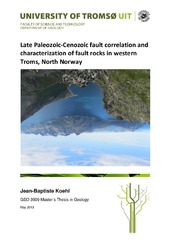Structure and flow properties of syn-rift border faults: The interplay between fault damage and fault-related chemical alteration (Dombjerg Fault, Wollaston Forland, NE Greenland)
Permanent lenke
https://hdl.handle.net/10037/9858DOI
dx.doi.org/10.1016/j.jsg.2016.09.012Dato
2016-09-29Type
Journal articleTidsskriftartikkel
Peer reviewed
Forfatter
Kristensen, Thomas B.; Rotevatn, Atle; Peacock, David C.P.; Henstra, Gijs A.; Midtkandal, Ivar; Grundvåg, Sten-AndreasSammendrag
Structurally controlled, syn-rift, clastic depocentres are of economic interest as hydrocarbon reservoirs; understanding the structure of their bounding faults is of great relevance, e.g. in the assessment of fault-controlled hydrocarbon retention potential. Here we investigate the structure of the Dombjerg Fault Zone (Wollaston Forland, NE Greenland), a syn-rift border fault that juxtaposes syn-rift deep-water hanging-wall clastics against a footwall of crystalline basement. A series of discrete fault strands characterize the central fault zone, where discrete slip surfaces, fault rock assemblages and extreme fracturing are common. A chemical alteration zone (CAZ) of fault-related calcite cementation envelops the fault and places strong controls on the style of deformation, particularly in the hanging-wall. The hanging-wall damage zone includes faults, joints, veins and, outside the CAZ, disaggregation deformation bands. Footwall deformation includes faults, joints and veins. Our observations suggest that the CAZ formed during early-stage fault slip and imparted a mechanical control on later fault-related deformation. This study thus gives new insights to the structure of an exposed basin-bounding fault and highlights a spatiotemporal interplay between fault damage and chemical alteration, the latter of which is often underreported in fault studies. To better elucidate the structure, evolution and flow properties of faults (outcrop or subsurface), both fault damage and fault-related chemical alteration must be considered.
Highlights
• Faults juxtaposing syn-rift clastics against crystalline basement are investigated.
• Early fault-zone diagenesis profoundly influences later fault-related deformation.
• Spatiotemporal interplay between fault damage and chemical alteration.
• Findings have implications for fault-bounded syn-rift reservoirs in the subsurface.
Highlights
• Faults juxtaposing syn-rift clastics against crystalline basement are investigated.
• Early fault-zone diagenesis profoundly influences later fault-related deformation.
• Spatiotemporal interplay between fault damage and chemical alteration.
• Findings have implications for fault-bounded syn-rift reservoirs in the subsurface.
Beskrivelse
Publisher's version, source: http://dx.doi.org/10.1016/j.jsg.2016.09.012.
Forlag
ElsevierSitering
Journal of Structural Geology 2016, 92:99-115Metadata
Vis full innførselSamlinger
Relaterte innførsler
Viser innførsler relatert til tittel, forfatter og emneord.
-
On Palaeozoic-Mesozoic brittle normal faults along the SW Barents Sea margin: fault processes and implications for basement permeability and margin evolution
Indrevær, Kjetil; Stunitz, Holger; Bergh, Steffen G (Journal article; Tidsskriftartikkel; Peer reviewed, 2014) -
Late Paleozoic-Cenozoic fault correlation and characterization of fault rocks in western Troms, North Norway
Koehl, Jean-Baptiste Philippe (Master thesis; Mastergradsoppgave, 2013-05-29)The present work focuses on the mapping and description of onshore brittle fault zones on the SW Barents Sea Margin, within gneisses and granitic intrusions belonging to the West Troms Basement Complex. The description of the brittle structures includes the geometry, kinematics and fault rock characteristics, using DEM satellite imaging, structural field work and a microstructural analysis of the ... -
Neoproterozoic and post-Caledonian exhumation and shallow faulting in NW Finnmark from K–Ar dating and p/T analysis of fault rocks
Koehl, Jean-Baptiste P.; Bergh, Steffen G; Wemmer, Klaus (Journal article; Tidsskriftartikkel; Peer reviewed, 2018-07-20)Well-preserved fault gouge along brittle faults in Paleoproterozoic, volcano-sedimentary rocks of the Raipas Supergroup exposed in the Alta–Kvænangen tectonic window in northern Norway yielded latest Mesoproterozoic (approximately 1050 15 Ma) to mid-Neoproterozoic (approximately 825–810 18 Ma) K–Ar ages. Pressure–temperature estimates from microtextural and mineralogy analyses of fault ...


 English
English norsk
norsk


